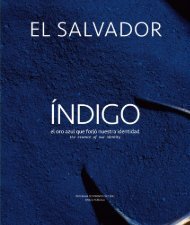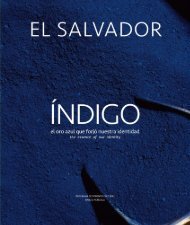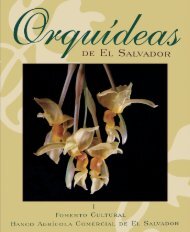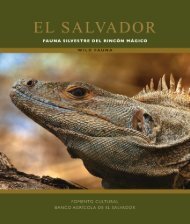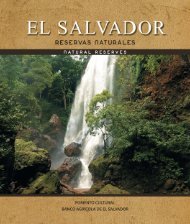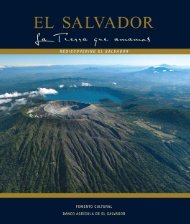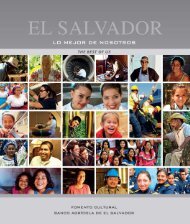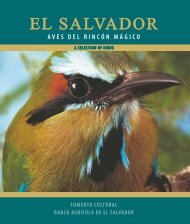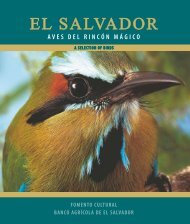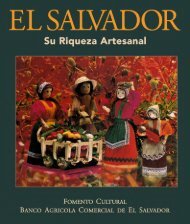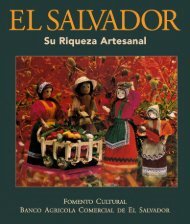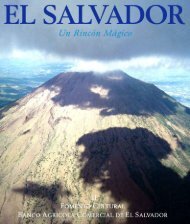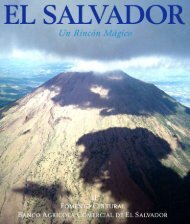Monumentos y Esculturas
Create successful ePaper yourself
Turn your PDF publications into a flip-book with our unique Google optimized e-Paper software.
Monumento a Atlacatl, Antiguo Cuscatlán.<br />
Monument of Atlacatl, Antiguo Cuscatlán.<br />
Escultura Indio Atlacatl, escultor Joaco, Avenida Independencia.<br />
Sculpture of Atlacatl the Indian, sculptor Joaco, Avenida Independencia.<br />
ESCULTURA DEL INDIO ATLACATL<br />
Atlacatl es la imagen más difundida de la identidad salvadoreña,<br />
aunque su existencia histórica no está comprobada. Su difusión<br />
representa el triunfo de un mito.<br />
SCULPTURE OF ATLACATL THE INDIAN<br />
Atlacatl is the most widespread image of the Salvadoran<br />
identity, although his historical existence is unproven. Its<br />
diffusion represents the triumph of a myth.<br />
Escultura del Indio Atlacatl de Valentín Estrada. Fue colocada en el Paseo<br />
Independencia en 1928 y actualmente está en la Colonia Atlacatl.<br />
Sculpture of Atlacatl the Indian by Valentin Estrada. Was placed on Paseo<br />
Independencia in 1928, currently in Colonia Atlacatl.<br />
La primera vez que los salvadoreños conocen sobre Atlacatl<br />
es en 1925, cuando el historiador Jorge Lardé y Larín reseña su<br />
triunfo sobre Pedro de Alvarado. Entre 1926 y 1928, escritores<br />
como Francisco Gavidia y Carlos Bustamante escriben poesía<br />
y gesta para ensalzar las inexistentes heroicidades del indio;<br />
pero ninguna de las historias es comprobada, como revela la<br />
investigación del historiador contemporáneo Carlos Gregorio<br />
López Bernal.<br />
A inicios del siglos, en El salvador la rigurisidad científica es<br />
sacrificada en pos del establecimiento de la apropiación de<br />
lo nacional. La escultura de Atlacatl, de Valentín Estrada, no<br />
fue ejecutada por Estrada para inmortalizar al héroe; el indio<br />
fue forjado a la imagen y semejanza del escultor, por lo que<br />
llegó a ser conocido como Valentín Estrada “el indio Atlacatl”.<br />
Este héroe mítico ha sido representado en tres esculturas en<br />
diferentes épocas en San Salvador y Antiguo Cuscatlán.<br />
The first time that Salvadoreans know about Atlacatl is in<br />
1925; when the historian Jorge Lardé y Larín reviews his win<br />
over Pedro de Alvarado. Between 1926 and 1928, writers like<br />
Francisco Gavidia and Carlos Bustamante write poetry and epic<br />
extolling the non-existent heroics of the Indian, but none of the<br />
stories is true, as the research by contemporary historian Carlos<br />
Gregorio López Bernal reveals.<br />
At the beginning of the century in El Salvador, scientific rigor<br />
is sacrificed in pursuit to establish the ownership of everything<br />
being national. Atlacatl’s sculpture by Valentin Estrada was not<br />
executed by Estrada to immortalize the hero; the Indian was<br />
forged in the image and likeness of the sculptor, so he became<br />
known as Valentin Estrada; “Atlacatl the Indian”. This mythical<br />
hero has been represented in three sculptures at different times,<br />
in San Salvador and Antiguo Cuscatlan.<br />
94 95



